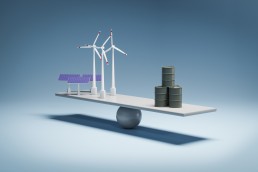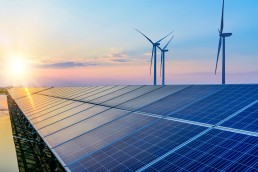Unique use cases is the best way to showcase the capabilities of the software. Our slope case study will help you see how our software solves complex solar engineering issues. This time we are going to look into the solar plant project situated between two hills with the potential shading issues.
The challenge for this site is the location in the valley between two hills with the potential for horizon shading issues. The site is located in the TOU territory, therefore the tracker system would be an ideal option for higher production. However, the initial assessment shows the conformity of the site to be challenging to construct a tracker system. So, we should look at the differences between trackers and fixed-tilt to present an alternative solution.
Introduction
The project we will be looking at in this case study is in the early stage of development. The land available for development is 171.45 acres (7468705 sq. ft). The goal is to find out if the size and the production of the solar system are economical to develop and whether this site is feasible to construct.
Another aim is to calculate if this site is buildable and what type of system is more suitable to build on a site like this by comparing the key values below between single-axis trackers and fixed-tilt systems.

First of all, it is necessary to have topography data, and know the limitations of each racking system that will be built on this site. In this case, we have our preferred racking vendor and the following slope limitation parameters — 10 degrees for a single-axis tracker and 17 degrees for the fixed-tilt system.
Procedures
To achieve the goal of this study, we are going to begin with using the terrain mesh feature in PVcase. This tool allows us to generate the 3D ground surface from the topographic data. This will help us visualize the site for a more efficient slope study. If the topographic information is not available for you to generate the terrain mesh, you can utilize PVcase Online Terrain Import feature (step-by-step instructions here).
First, we generate the 3D terrain mesh (step-by-step instructions here). We are going to utilize the Slope setup table, where you can control how detailed the terrain mesh should be and what slope direction you want to study for a particular system: north-south for single-axis trackers, east-west for fixed-tilt. To break down the slope changes, we start both systems at a 0-degree slope. The ending value is set higher at 20 degrees for the fixed-tilt system compared to 15 degrees for the single-axis tracker system due to each system’s limitations. This value is also slightly higher than their limitation to maximize the capacity and later utilize the ground grading tool (step-by-step instructions here) to determine the civil work necessary for this site once the capacity is optimized.
Single-axis trackers system:

Slope table interpretation:

Site generation and visualization
With a similar frame preset, we have 2 types of frames: 26 modules, and 13 modules. Each frame has 1 module in portrait for both fixed-tilt and tracker sites to maximize the capacity. The sites are set up with the sun angle at 25.63 degrees on December 21 at noon.

At this point, we can export the layout to PVcase Yield or PVsyst (step-by-step here) for production simulation to compare the 2 systems.
Production results:

Interpretation
Table 1 outlines the key performance between the 2 sites. Due to the single-axis tracker system having a low slope tolerance, compared to the fixed-tilt system, the fixed-tilt layout has a higher capacity. Despite having a higher specific production and GCR, the tracker layout for this site is particularly challenging. The site limits tracker layout to 14.405 MW, which is 32.25 % less in comparison to a traditional fixed-tilt system. The fixed-tilt layout experiences lower near shading, compared to the tracker layout with backtracking resulting in a 2.88% higher performance ratio and 25.15% overall produced energy. In addition, the fixed-tilt site requires 27.96% less land to achieve a higher capacity, and therefore cheaper in terms of land leasing/purchasing prices.
With the production indicators above, it is more beneficial for owners to utilize the fixed-tilt layout at this particular site because of the higher capacity fit on the site, and the energy export back to the grid. In terms of mechanical, fixed-tilt frames handle higher slope deviation better, which is a better fit for this particular site. On the contrary, the tracker layout falls short for this type of terrain because of its slope limitation. The tracker layout experiences significantly less capacity, and even with 27.97% higher in GCR, the overall production is 25.15% less than the fixed-tilt layout.
Conclusion
So, let’s see which system is suitable and whether the site is buildable. The results of the key values show us that a fixed-tilt system is a better approach for high level development at sites with higher slope variance. With the initial evaluation, using the fixed-tilt approach makes this site a possible buildable site.
The terrain mesh tool could be used along with other features within PVcase to make decisions at the early stage of project development. In this slope study we used the terrain mesh, terrain-based site generation, and PVcase Yield or PVsyst export features to help the users understand the best fit system for the given site, and therefore maximize capacity, and production while eliminating unfavorable or unnecessary risk options.
You might also be interested in:
October 10, 2024
Net energy metering: how does it work and what are the benefits?
Learn about net metering, how it works and its benefits for renewable energy users and the grid.
October 9, 2024
Solar lease vs. buy: which is better?
Explore the benefits and drawbacks of leasing or owning solar panels to determine the best option for your renewable energy needs.
October 8, 2024
Solar energy vs. fossil fuels: what’s the difference?
Want to understand the differences between solar energy and fossil fuels? Explore the pros and cons, including their environmental impacts and financial considerations.
October 7, 2024
Is solar power truly renewable or nonrenewable?
Discover whether solar energy is considered renewable or nonrenewable and explore the benefits of solar power for a sustainable future.
October 6, 2024
Understanding on-grid solar systems. Powering homes and businesses
Find out how grid-tied solar systems work, their advantages and why they're popular for homeowners and businesses looking to harness solar energy efficiently.
October 4, 2024
Solar energy vs. wind energy. Pros and cons
Discover whether solar energy is considered renewable or nonrenewable and explore the benefits of solar power for a sustainable future.
October 3, 2024
Achieving household energy independence
Discover how energy independence through solar power can benefit your household, reduce costs, and contribute to a sustainable future.
October 2, 2024
Solar powered water heaters. A comprehensive guide to their value and efficiency
Many people in rural areas have difficulty accessing financial services, a problem exacerbated by energy insecurity. Solar power can help protect rural communities from energy…
October 1, 2024
Separating solar energy facts from fiction
Explore common solar energy myths and facts. Learn the truth about the efficiency, costs, and environmental impact of solar power in this guide.
September 30, 2024
Essential solar panel maintenance for peak performance
Learn key strategies for solar panel upkeep, from regular cleaning to performance monitoring. Maximize efficiency and extend system life.
September 27, 2024
Understanding smart power grid technology
Discover how smart grids modernize power systems, enhance efficiency and integrate renewable energy sources for a sustainable future.
September 26, 2024
Why do solar panels degrade?
How and why do solar panels degrade? Explore the factors contributing to their lifespan and what measures to take to extend it.
September 25, 2024
Solar panel and battery recycling
Learn effective techniques for recycling solar panels and batteries. Discover sustainable practices, legal requirements, and the environmental impact of proper disposal methods.
September 24, 2024
Will urban air transportation become widely available?
Learn about the latest innovations and practices that can further improve the sustainability of climate-resilient crops, benefiting both farmers and the environment.
September 23, 2024
Emerging innovations in unmanned systems
Unmanned systems can perform various tasks without the hands-on operation of a human, although they’re often operated remotely. These systems are increasingly being used in…

















